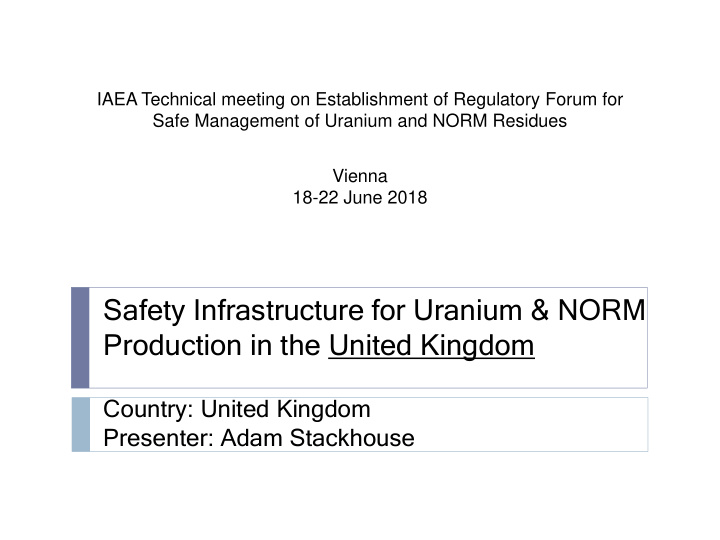



IAEA Technical meeting on Establishment of Regulatory Forum for Safe Management of Uranium and NORM Residues Vienna 18-22 June 2018 Safety Infrastructure for Uranium & NORM Production in the United Kingdom Country: United Kingdom Presenter: Adam Stackhouse
Contents Legislation and Regulatory Framework Regulatory bodies Uranium related activities Other NORM related activities Licensing Process Management of residues, decommissioning and remediation Challenging issues
Legislation and regulatory framework
Regulatory framework The cake is “sliced up” and based on topics and given to the regulatory authority that deals with that topic e.g. environmental + public protection (waste management): environment agencies health and safety at work: health and safety executive nuclear safety: office for nuclear regulation safety of consumer products safety of building materials patient protection
What do the environment agencies do? Regulate all waste management Specifically for radioactivity:… Issue licenses for disposal Discharges to air, water, sewer; burial; transfer of waste to other people Implement ALARA principle by requiring license holders to optimise Use BAT to minimise waste generated Use BAT to minimise discharges to the environment Use BAT to minimise effects of discharges/disposals Same for everyone, Nuclear, non-nuclear and NORM
How NORM is captured by the legislation Substances are captured by legislation if from a listed NORM industrial activity and if NORM concentrations exceed specified values (e.g. clearance values) For solids: 1 Bq/g except for parts of decay chain where higher values are used (derived from a 300 μ Sv/a public dose – EC RP122 part 2) For liquids and gases: Values derived using 300 μ Sv/a public dose (e.g. for liquids1 Bq/l Ra-226 and 0.1Bq/l Ra-228)
Uranium related activities The UK does not have any current uranium mining or milling related activities Some historic production of uranium at the end of the 19 th century (few hundred tonnes – mostly used for colouring stained glass) Further detail in a British Geological Survey document: https://www.bgs.ac. uk /downloads/start.cfm?id=1409
NORM related activities The UK NORM Waste Strategy summarises NORM related activities in the UK Comprehensive data collection exercise carried out in 2013
Most significant NORM industries in UK Oil and gas Steel Titanium dioxide
Licensing Process Types of licenses Exemption No review or approval process Registration For specific activities where assessments Approval process is focused on capability of operator rather than activity they wish to do Issued in 28 days Permit Site specification information required – must know characteristics of residues and have a management plan, public dose assessment Detailed assessment Aim to issue in 4 months
Management of residues, decommissioning and remediation
UK Oil and gas industry Generate solid and liquid NORM wastes >100 installations offshore = >98% of UK oil and gas production
Solid waste How much? ~800 tonnes per year Generally 10s Bq/g can be 100s ~ 6.4 GBq Ra-226 Can contain HC’s heavy metals etc. Disposal routes: Offshore Directly to sea or injection Onshore ~ 160 t containing 4 GBq Ra-226 Burial (usually following treatment) Incineration
Solid waste issues Oil and gas decommissioning Availability of decommissioning facilities Uncertainties of quantities of NORM Transboundary movement – lack of common controls Impact of zero waste policies on practice of co-disposal at landfill Is treatment always necessary – or is it just dilution Some countries now seeking to use facilities for NORM management in the UK? Is this ok? How does it fit with principle of self-sufficiency
Liquid wastes: PW quantities Offshore ~ 200 million m 3 per year Majority discharged to sea Some re-injected Onshore ~ 12 million m 3 per year (95 % is from one facility and is re-injected) Unconventional gas ???? Nothing at the moment How will it be managed
Steel Industry • Generate solid and gaseous NORM waste • 3 Steel plants in the UK
Steel industry gaseous limits During sintering process (step prior to blast furnace) Some polonium and lead released as it is volatile Significant quantities discharged (public dose trivial: a few microsieverts)
Steel industry Solid waste generated from the gas cleaning system contains Po and Pb the concentration depends on the technologies used. 1 site currently generate ~ 10 000 tonnes per year of residue containing 5 – 12 Bq/g Pb-210 so requires permitting as rad waste suitable for use in cement making Cement industry not interested if “radioactive waste” Issues: “label” - sometimes the name we give to residues causes problem Mixing - Is it acceptable to mix with other similar waste to reduce activity and facilitate its use
Titanium dioxide industry Generate solid and liquid NORM waste Solid ~200 000 tonnes of residue ~ 1 Bq/g ~ 10 tonnes of filter cloths 100s Bq/g Liquid 3-4 million m 3 liquid effluent – authorised to be discharged to an estuary
Challenging issues - summary Preparing for decommissioning Lack of harmonisation e.g. impacts transboundary movements How to deal with liquids proportionately Mixing, treatment and dilution Communication and understanding / operators and public 22 6/21/2018
Thank you
Recommend
More recommend